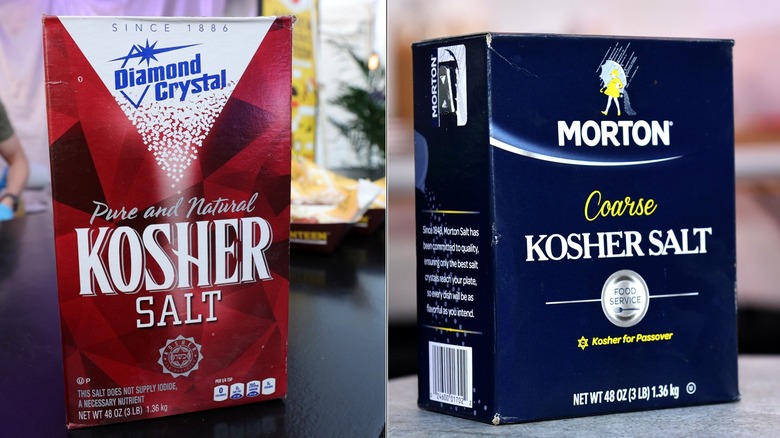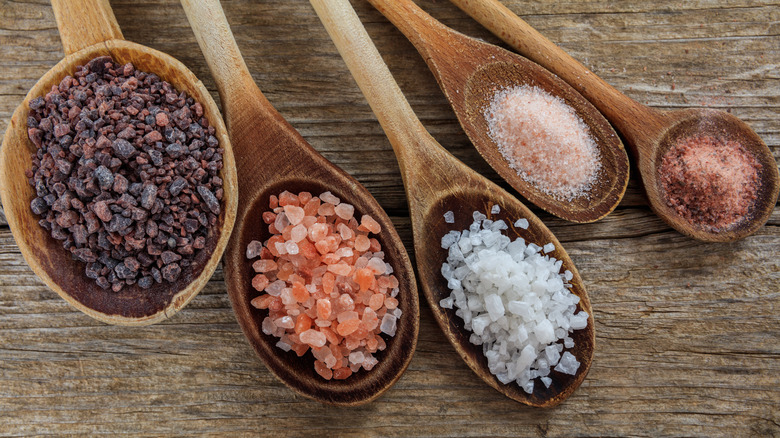The Reason Ina Garten Refuses To Use Table Salt
Table salt was the only salt home cooks used for generations. The fine white grains filled salt shakers on kitchen and restaurant tables nationwide long before we were introduced to different colors and sizes of salt grains. Professional chefs, however, commonly reach for kosher salt for all their cooking and baking needs — and for good reason.
When a confused fan asked Ina Garten which type of salt to use when cooking or baking, the Barefoot Contessa didn't shy away from her clear preferences. While some cooks vary the type of salt they use depending on the recipe, Garten uses Diamond Crystal kosher salt in all of her recipes, adding on her website, "I never use table salt because it has a metallic taste and tastes extremely salty."
The metallic taste Garten references is the iodine that's been added to table salt in the United States since the 1920s to combat a growing thyroid and goiter issue in the U.S. population. Unlike sea salt, which is less processed, table salt is stripped of its natural minerals. Although table, kosher, and sea salt have similar nutritional value and sodium content by weight, their taste and texture are vastly different, making it impossible to substitute one-for-one in recipes. As Garten points out, even the brand you use makes a significant difference.
The difference in kosher salt brands
The size of the granule and brand is a crucial factor when switching between types of salt. In general, the finer the grain, the saltier it will be. Ina Garten explains that fine table salt is the saltiest per teaspoon, followed by kosher, sea, and fleur de sel. As the flakes get larger, fewer granules can fit in a teaspoon, affecting how salty the measurement is. It's easier to over-salt a dish when using fine table salt, which is partly why professional cooks prefer coarse kosher salts. It's easier to control. However, keep in mind that kosher and sea salts are also available in fine and coarse grain sizes.
Diamond Crystal and Morton are the leading manufacturers of kosher salt. On the surface, you may not be able to see a difference, but switching between the two in a recipe can result in the dish being too salty or under-seasoned.
Between the two brands, Diamond Crystal kosher salt has a larger, more delicate granular, making it significantly less salty than the denser Morton salt. One serving (¼ teaspoon) of Diamond Crystal coarse kosher salt contains 280 milligrams of sodium – whereas Morton's has 480 milligrams. Well-written recipes like Garten's will specify which salt was used in testing the recipe. If not, assume the recipe was written with Diamond Crystal kosher salt in mind and add more salt during the cooking process if necessary and only after tasting.
When to use finishing salt
High-end specialty stores can dedicate an entire aisle to different types of salt these days. Even the local grocery store has started selling a variety of salt at vastly different price points, which can be confusing and leave home cooks wondering if they need to spend so much on Maldon sea salt.
The short answer is yes. Experienced cooks know that good food needs to be seasoned at every stage of cooking, including right before serving when finishing salts are used. This salt category isn't used during the primary cooking stage, like when salting a pot of water for pasta. That would be too costly and unnecessary since you couldn't appreciate the subtle taste of that particular salt.
Finishing salts like fleur de sel, Himalayan pink salt, and sel gris add subtle mineral notes to dishes. Their flavors are delicate, so they are not meant to be cooked and lost. Each variety is mined in a different global region, offering a striking color contrast on food in pinks, greys, and black. Their large, craggy shape makes them difficult to measure for recipes but adds a salty crunch when added just before enjoying.



